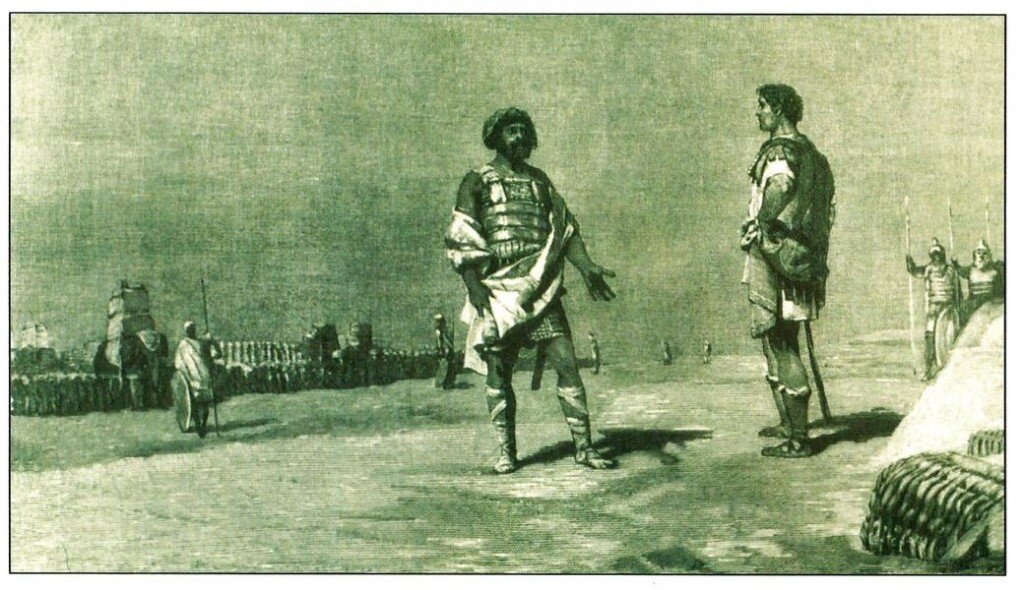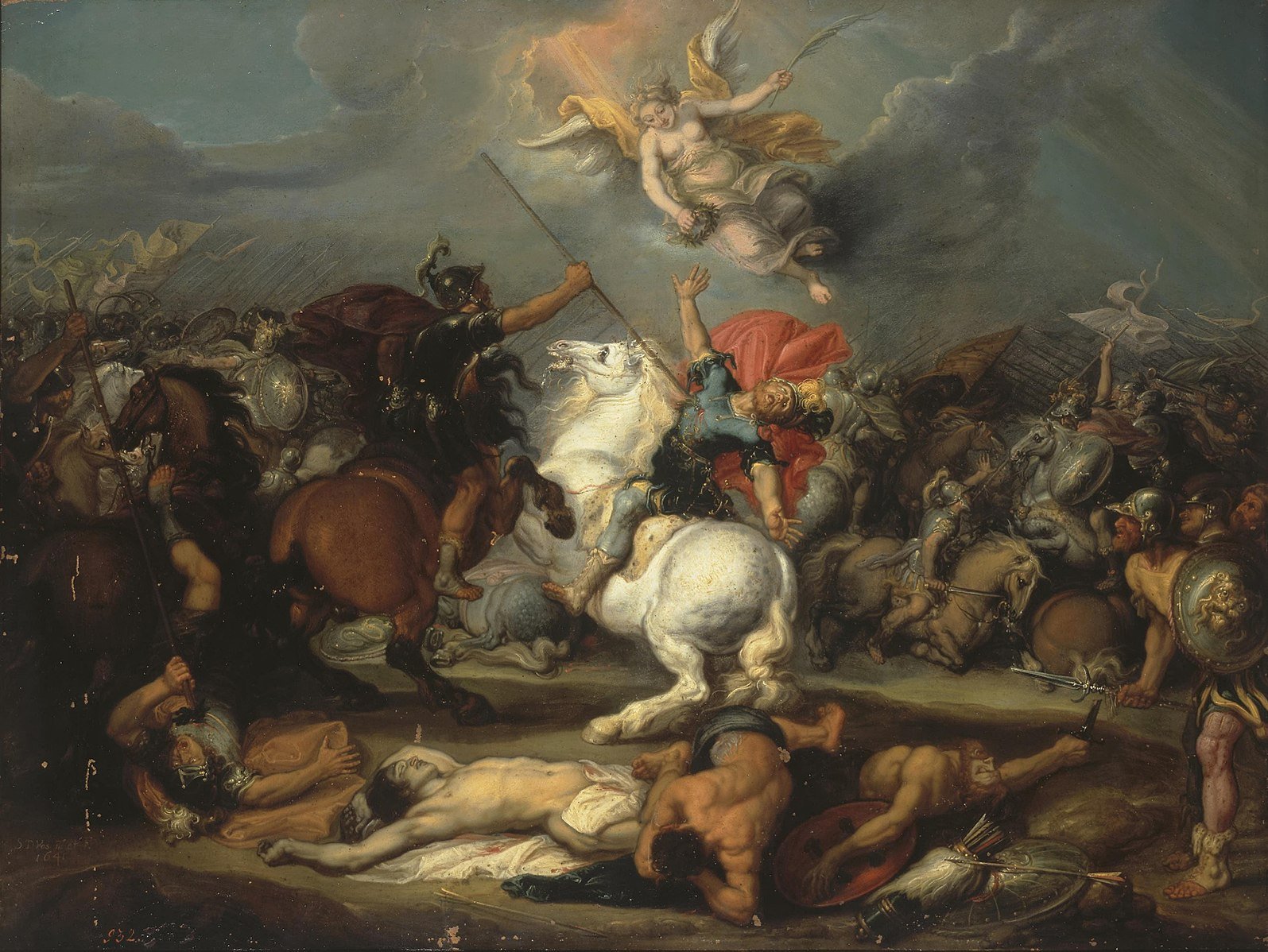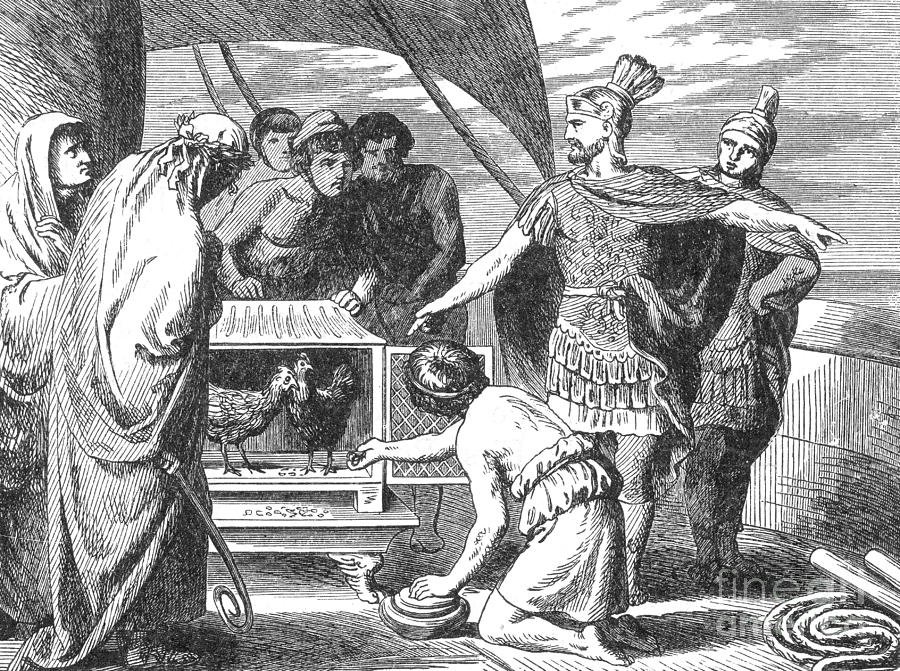The Third Century BC in Five Roman Battles
In which Tim continues his Roman history via five battles per century. Read about previously explored centuries and their battles here.
Hannibal, Scipio Africanus, Cannae, Fabius Maximus, war elephants, the crashing together of galleys in the Med, drowned chickens; the third century was a pivotal century in the development of Rome.
At the start of the century (299BC - to be clear!) Rome was a small, but growing, Italian power. By the end of the century it was a major Mediterranean player with an overseas empire and poised to get much larger. The common theory is that Rome never sought to be an empire, it just fought one defensive war after another, each success leading to a new enemy further and further from the actual city of Rome. Maybe that theory is true, maybe not (later date: Caesar & Pompey rather argue against it) but the 3rd century BC does demonstrate how each entanglement could lead to the next.
We all know about Hannibal and his crossing of the Alps with elephants. It’s one of those basic touch points from history - a bit mythical, a bit hazy, but we all sort of know the story. The 2nd Punic War was an epic conflict, a life and death struggle that could have caused the collapse of Rome. From this period (218 to 202) we’ll take two epic battles - Cannae 216 and Zama 202.
But the wars of Hannibal are but part of the tale of the third century BC. The Battle of Telemon 225 was a significant battle that ended one question only to open another. Plagued by the troublesome Celts on their northern border, Telemon (and it’s follow up victories), removed the immediate menace of the Celts. But it also made the Celts resentful and ripe for an alliance with a certain Carthaginian general as he passed through their territory seven years later. From the killing grounds of Telemon begat the massacres of Cannae and Lake Trasimene.
Skipping over the 1st Punic War, we go back a bit further and meet another historically well remembered figure - King Pyrrus of Epirus. From this earlier part of the century, we’ll take a look at The Battle of Asculum 279 where all those pyrrhic victories started to catch up with Pyrrhus.
And starting off the century, we have Rome clearing the way to Italian dominance with The Battle of Sentinum 295 which was the decisive battle in the Third Samnite War.
A quick word on the Roman armies of this period. This was pre-Marian reforms and so the army was made up from levies of eligible citizens who put down their ploughs for the campaign season and went off to fight for the Roman state. Each year two consuls were elected and each consul had a consular army of roughly 20,000 men made up of two Roman legions and two allied legions. The legions themselves were made up of three classes of soldiers, divided by age and experience - the hastati, principes and, the veteran triarii. Light troops the verites and the cavalry made up the rest of the army.
The Battle of Sentinum 295
Simon de Vos - Death of Decius Mus. The Roman counsel pushes too far and is killed at The Battle of Sentinum
The Samnites were Italian rivals - a large confederation of tribes in middle Italy. As Rome grew, they tended to butt against their neighbours more and more. Three wars were fought agaionst the Samnites and Sentinum was the pivotal battle of the third and final war. Interestingly enough, although conquered, resentment continued between the two tribes which came to a head in the Social Wars two hundred years later and - following the battle of The Colline Gate - Sulla massacred 8000 Samnite prisoners as the Senate - next door but hearing the cries of the dead and dying - voted through his dictatorial powers.
Rome always prided itself that it only fought defensive wars but often acted as a provocateur - goading other states to declare war. Alarmingly, in the 290’s, they managed to provoke the Samnites into joining with three other tribes - the Etruscans, Umbrians and Senone Gauls - to take on the growing arrogance of their upstart neighbour. Consuls and proconsuls were dispatched to face this threat and two, Quintus Fabius and Publius Decius, squared up to a large army of Samnites and Gauls at Sentinum in 295.
The battle is remembered best for the sacrifice of one of the consuls - Publius Decius - seeking to rally his troops as their lines were broken by the Gauls following a failed cavalry charge. His sacrifice worked - or at least the reinforcements Quintus Fabius sent stiffened the resolve of the wavering troops - and the battle turned in Rome’s favour. Quintus outflanked the Samnites with his cavalry and they were routed leaving just the Senone who were now surrounded and destroyed.
The Samnite coalition broke up following this loss, leaving just the Samnites themselves to face the victorious Romans who prosecuted the war for a further five years before Samnite capitulation. The dominance of Italy pushed further down the peninsular.
The Battle of Asculum 279
"If we are victorious in one more battle with the Romans, we shall be utterly ruined."
And so King Pyrrhus of Epirus gave us the phrase ‘Pyrrhic Victory’ after his ‘victory’ against the Romans and allies at The Battle of Asculum 279BC. Pyrrhus is an interesting character from ancient history. He was king of Epirus, the border Greek state next to Macedonia and opposite the Italian peninsular. In the south of Italy at this time, there were many Greek cities. As we have seen, Roman power was extending down the peninsular and it was only a matter of time before the Romans and Greeks clashed.
This happened in 282BC. The cause is disputed. A Roman fleet was attacked by one such Greek city, Tarentum. Maybe. Or provoked into attacking. But it had the same effect; war between Rome and her allies and the Greek cities and their allies. One such ally came from Epirus back on the Greek mainland. The king of Epirus, Pyrrhus, crossed the narrow sea with an army organised around the phalanx, supported by war elephants and the dreams of creating an Italian empire.
Pyrrhus was a talented general - he beat the coalition of Roman led Italians at The Battle of Heraclea (280BC). He followed this up by marching on Rome itself but failed to take the city and so returned south for the winter. The two sides met again at Asculum the next year with around 40,000 troops each. Crucially, Pyrrhus’ elephants were to play a major part in the subsequent Greek victory (though the Greek coalition had now been joined by many Italians including the ever present Samnites).
The armies lined up and locked into an infantry melee whilst on the wings the elephants and cavalry fought it out. The Roman infantry was having the better of the day in the middle and all sides watched as some Daunians - Roman allies - sneaked up from behind and sacked the Greek camp. However, at this moment the elephants broke free of their blockers on either flank and started to roll up the Roman infantry from left and right.
The Roman army retreated from the field losing nearly twice as many troops as the Greeks. The Romans though could make up these losses whereas Pyrrhus and the Greeks could not. Therefore, Asculum became the archetypal Pyrrhic victory. Rome’s advance down the Italian peninsular continued.
Pyrrhus himself went off adventuring and losing in Sicily against the Carthaginians, losing to the Romans back in Italy and was finally went back to Greece itself where he was killed in some street fighting in the Peloponnese by a tile thrown on his head by a woman from her roof.
First Punic War and the Chickens
Claudius Pulcher orders the chickens over the side.
We shall skip the First Punic War (264-241) where Rome took on the might of the African Carthaginian Empire. Not that there weren’t battles a plenty with lots of noteworthy anecdotes but are limited to just five battles. The two powers fought for twenty years with battles centred around Sicily and - new for the Romans - the sea. Large sea battles were fought in the Med and Rome quickly got good at this form of warfare.
One anecdote about Publius Claudius Pulcher and the chickens needs to be told. Romans were a suspicious lot and always looking for signs of blessings from the divinities. One ritual involved examining the behaviour of the sacred chickens before a battle. Depending on how they ate the seeds laid out for them, the Romans could predict good fortune or not. Before the important naval battle of Drepana, Pulcher’s chickens refused to eat - a very bad omen. So he threw them overboard and into the sea: ‘Since they do not want to eat, let them drink!’ he apparently said - wit being important even back in ancient Rome. Obviously he then went onto catastrophically loose the oncoming battle with most of the Roman fleet annihilated. Lesson: Don’t mess with the chickens!
Telemon 225 BC
Rome was sacked in 390 BC by an army of Gauls. Subsequent generations of Romans never forgot this humiliation and so harboured a long held resentment and fear of the Celtic tribes to the north. As Rome expanded over the next one hundred and fifty years with various tribal wars and alliances, the Gauls began to fear they would be next on the hit list, especially after Rome started sending settlers into nearby lands. Deciding that attack was the best form of defence, a large confederation of Gauls from both Cisalpine Italy and France got together and started heading towards Rome in search of plunder.
But this was not the Rome of 390. Having emerged stronger and more disciplined followed the first Punic War, Rome and her allies (who also feared the Gallic invasion) fielded three large armies. One army took the fight to the Gauls’ homelands whilst the other two - under consuls for the year Gaius Regulus and Lucius Papus created, in effect, a pincer movement with the marauding Gauls trapped in between. The site of the battle was Telemon (modern Telemone) about 70 miles from Rome.
The Romans and allies outnumbered the Gauls (something like 100,000 to 70,000) and were better organised and disciplined. Some of the Gauls - like the Gaesatae - fought naked which - with arrows and spears and sling shot flying around - didn’t help much in the ensuing battle. As is often the case in ancient battles, there were in fact, two engagements, an infantry crush and a separate cavalry battle nearby. At Telemon, the Romans won the cavalry battle and so returned to the infantry battle to tip the scales for their side.
The Gauls stood and fought but 40,000 - surrounded - were massacred and 10,000 captured. The consul Regulus died in the battle but his colleague Papus didn’t and led his victorious troops into the Gaulish territories to extract revenge, plunder and lands. Further victories followed in the next couple of years and more Roman settlers were given lands previously occupied by the Gauls.
So, when Hannibal was looking for allies soon after to support his invasion of Italy, guess which bunch of dispossessed and angry tribes he found favour with?
Cannae 216, Zama 202 & The Second Punic War
“Such was the result of the battle between Hannibal and the Romans at Cannae, which was begun after the second hour of the day and ended within two hours of night-fall, and which is still famous among the Romans as a disaster, for in these few hours 50,000 of their soldiers were slain and a great many taken prisoners.” Appian - The Foreign Wars
Games of Thrones recreated Cannae as The Battle of The Bastards. Hannibal out thought and out fought two consular armies and eight legions and massacred them in this battle down in the south of the Italian peninsular. The way to Rome lay open but Hannibal inexplicably missed his opportunity being more concerned with ransoming captives than following up on his stunning victory (though it is true, Carthage perversely ignored Hannibal’s requests for more troops and money to win the war).
Hannibal had invaded Italy two years earlier by crossing the Alps with a Carthaginian army made up of many nations, many tribes. Early victories in 218 and 217 made the Romans wary of tackling Hannibal so, at Cannae, they gathered a huge army led by the two consuls to put an end to him once and for all. What happened next was that Hannibal used the sheer weight of Roman numbers against them by enveloping their army with his own troops providing no way out of the slaughter for the penned in legionaries. The Roman army was systematically annihilated with perhaps 50,000 deaths and around 20,000 taken prisoner.
Rome lost its Italian allies in the South and the majority of its fighting forces. The City mourned for 30 days, human sacrifices were reinstated to appease the gods but, ultimately, more armies were raised and Hannibal was pinned down in the bottom of Italy for the next ten years. He’d won the battle but lost the war. In fact, a young Roman survivor from Cannae, Scipio Africanus, would come back to avenge the losses on this day.
Young Scipio - bearer of a famous name - was also personally invested in the fight against the Carthaginians. Some might say that Punic War 2 became a grudge match between the Scipios and the Barcas. As the Romans fought Hannibal in Italy, a second front was being busily engaged in Spain. Early in the conflict Scipio’s father and uncle were both killed in the Iberian conflict. This was personal for Scipio and he begged the Senate to allow him to take command of the depleted and demoralised Roman forces in Spain. His confidence (arrogance even) impressed them and - with no other candidates - gave the young man charge of the army.
Scipio turned the war around, eventually driving the Carthaginians out of Spain. He now took the fight to the Africans and invaded their homeland. Hannibal, still in Italy, was recalled and the stage was set for the final showdown of the Second Punic War.
Battle of Zama 202 BC
It is rumoured that Hannibal and Scipio met in person in the land between their two huge armies before the Battle Zama. (Interestedly enough, they also met many years later at a banquet). If they did then it was an historic meeting; the two famous generals whose personal qualities and leadership summarised the Second Punic War.
At Zama, Hannibal had the larger army, Scipio had the larger cavalry forces. Hannibal used elephants which proved ineffective and even counter productive. Whilst the infantry slogged it out over many hours, pretty evenly matched, the cavalry fought at the wings with the Romans (and their Numidian allies) proving the stronger. So it was that the Roman cavalry returned at a crucial point and attacked the Carthaginians from the rear. The Carthaginian army was destroyed though Hannibal escaped. The Second Punic War was over.
So the Third Century ended with the Romans triumphant in the Western Mediterranean. Her existential enemy for much of the century - Carthage - had been humiliated and forced to pay huge tributes as well as other harsh treaty terms. The next century would see the final defeat and destruction of Carthage.
However, more than the defeat of Carthage, the Romans had established themselves as the preeminent power on the Italian peninsular taking out the Samnites and Celts and many others. From now on, whilst there were the occasional challenges, there was only one real power in Italy.
But more than this. The third century had shown that Rome was resilient. The disaster of Cannae - so very nearly a knockout blow - had been dealt with, more armies raised and the war won. With the west secured, Rome would now increasingly look East to that other great power, Macedonia and the Greek city states. Her star was in the ascendent. At home though, things started to fall apart for the republic. That though, is in the next episode.
If you enjoyed reading about the battle of the 3rd century BC, why not try some other centuries in my Five Battles series?



